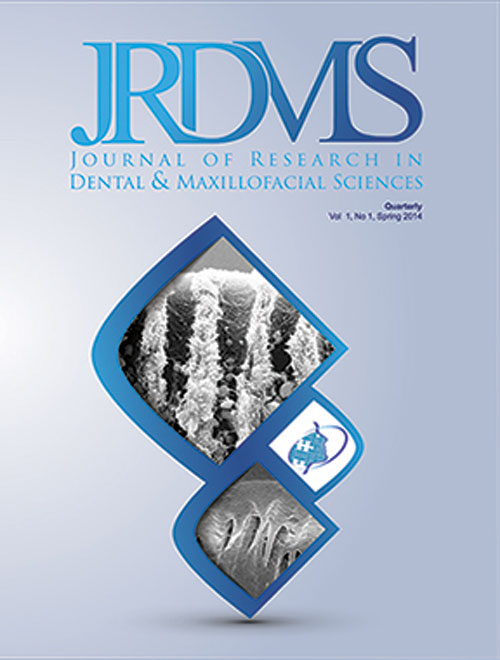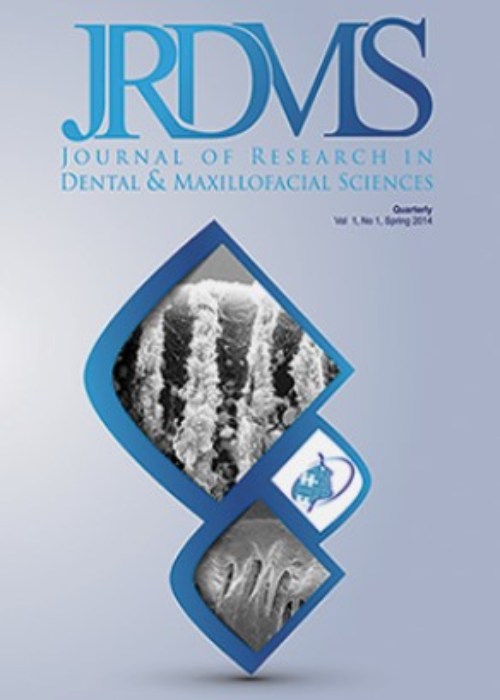فهرست مطالب

Journal of Research in Dental and Maxillofacial Sciences
Volume:4 Issue: 3, Summer 2019
- تاریخ انتشار: 1398/06/10
- تعداد عناوین: 7
-
Pages 1-4Background and Aim
The risk of surgical site infection may depend on bacterial attachment and physical and chemical properties of suture materials. This study aimed to evaluate bacterial accumulation on triclosan-coated (Vicryl Plus) and silk sutures placed at different distances from Vicryl Plus after dental implant surgery.
Materials and MethodsIn this randomized controlled trial, 20 patients who required dental implants were included. Their surgical sites were large enough to include at least four sutures. The surgical site was sutured first with Vicryl Plus and then with three silk sutures placed at 3, 6, and 9 mm distances from Vicryl Plus. Sutures were removed 7 days after surgery, and the samples were placed in microbiological cultures specific to Enterococci and Escherichia coli (E. coli). Subsequently, the numbers of colony-forming units (CFUs) and bacterial growth rates were evaluated. Kruskal-Wallis and Mann-Whitney U tests were used for statistical analysis.
ResultsThere were no significant differences in the number of CFUs and growth rates of microorganisms isolated from triclosan-coated and silk sutures 7 days postoperatively (P>0.05).
ConclusionTriclosan-coated sutures have no benefits over silk sutures placed at different distances from Vicryl Plus.
Keywords: Sutures, Surgical Wound Infection, Bacterial Adhesion, Polyglactin 910, pharmacology, Triclosan, Dental Implant -
Pages 5-14Background and Aim
Despite the advances in maxillofacial surgery, impaired bone healing remains a concern for surgical teams. Effects of sildenafil and pentoxifylline on healing of bone fractures have not been well investigated. This study aimed to assess the effects of sildenafil and pentoxifylline phosphodiesterase inhibitors on healing of mandibular fractures in rats.
Materials and MethodsIn this animal study, 48 Wistar rats were randomly divided into six groups (n=8). Mandibular fracture was induced in all rats. After the surgical procedure, C2 group (control, 2 weeks) received saline, S2 group (sildenafil, 2 weeks) received 10 mg/kg sildenafil, and P2 group (pentoxifylline, 2 weeks) received 50 mg/kg pentoxifylline. The rats were sacrificed after 2 weeks. C6 (control, 6 weeks), S6 (sildenafil, 6 weeks), and P6 (pentoxifylline, 6 weeks) groups received pharmaceutical therapy as in C2, S2, and P2 but were sacrificed after 6 weeks. The samples then underwent histological analysis. Data were analyzed using SPSS 22 via one-way analysis of variance (ANOVA) and Tukey’s post-hoc test.
ResultsThe mean rate of healing of mandibular fractures in S2 and P2 was significantly higher than that in C2 after 2 weeks (P<0.001). The mean rate of healing of fractures in P2 was higher than that in S2 after 2 weeks (P=0.04). The mean rate of healing of fractures in S6 (P=0.001) and P6 (P=0.004) was significantly higher than that in C6 after 6 weeks but no significant difference was noted between P6 and S6 in this respect (P=0.53).
ConclusionSildenafil and pentoxifylline can be used as adjuncts to enhance bone healing.
Keywords: Bone Healing, Mandibular Fracture, Pentoxifylline, Sildenafil -
Pages 15-20Background and Aim
Although the physical properties of modern glass ionomers have been extensively reported, few studies have examined how these parameters change with age. This experimental study aimed to investigate the effect of aging on the compressive strength of resin-reinforced glass ionomers.
Material and MethodsTwo glass ionomers (Fuji IX GP Fast, GC, Japan, and Ketac Universal, 3M, USA) and one composite resin (control; Filtek P60, 3M, USA) were chosen for this study. Both glass ionomers were encapsulated and mixed using an amalgamator and were applied using an appropriate applicator. Forty cylindrical (4×6 mm2) samples were made of each material and subsequently incubated at 37°C with 95±5% humidity. Twenty samples from each material were then randomly selected to undergo aging in a thermocycling machine using 1000 cycles (between 5-55°C). The compressive strength of the samples was then measured using a universal testing machine. One-way analysis of variance (ANOVA) and post-hoc Tuckey’s test were used for data analysis.
ResultsThe aging process (thermocycling) caused a significant increase in the compressive strength of all three materials. Overall, Ketac Universal displayed higher compressive strength with an average value of 271.1120±15.4387 MPa and 248.6910±15.10716 MPa with and without aging, respectively, compared to Fuji IX GP and Filtek P60.
ConclusionThe aging process increases the compressive strength of glass ionomers and composites; however, even with aging, modern glass ionomers still struggle to achieve compressive strength values close to those feasible with composite resin. It is therefore essential to use these materials in non-stress-bearing areas.
Keywords: Aging, Compressive Strength, Glass Ionomer -
Pages 21-29Background and Aim
Patients affected by thalassemia major show great skeletal changes in the head and neck area in addition to malocclusion. It seems that examination of malocclusion in these patients and evaluation of the frequency of temporomandibular disorders (TMD) can help identify people with a high risk of illness in the society. The current study aimed to compare the frequency of TMD between β-thalassemia major patients and high school and guidance school students.
Materials and MethodsIn this descriptive-analytical study, 51 patients affected by thalassemia major (23 girls and 28 boys) and 78 normal (43 girls and 35 boys) guidance and high school students between 12 and 18 years old were evaluated. The presence of TMD and malocclusion and their relationship were determined. After examination and completion of the related questionnaire, data were analyzed by chi-square test and t-test using SPSS software.
ResultsAccording to the data, there was no significant difference in spacing, occlusion, crowding, open bite, headache, bruxism, crepitation, clicking, TMD, subluxation, locking, cleaning, deviation, deep bite, and crossbite between the control and thalassemia students (P>0.05). However, significant differences were observed regarding overjet and pain (P<0.05).
ConclusionThese results suggest that TMD and occlusion type have no significant correlation with thalassemia.
Keywords: Thalassemia, Temporomandibular Joint Disorders, Malocclusion -
Pages 30-35Background and Aim
Dentin hypersensitivity (DH) is one of the most common problems in dentistry. Several factors affect DH. This study aimed to determine the prevalence of this problem and identify the associated factors.
Materials and MethodsIn this cross-sectional study, 300 patients who referred to the operative dentistry department of Islamic Azad University of Medical Sciences, Tehran, Iran, were examined. Demographic information and other related factors were recorded using a questionnaire. One examiner then examined the subjects regarding the potential related clinical factors. DH was evaluated using evaporative and tactile tests and was categorized using the visual analog scale (VAS). Descriptive data were presented as frequency and mean. Chi-Square test was used to examine the related factors at the significance level of 0.05.
ResultsThe overall prevalence of DH was 21%. The correlation of horizontal brushing technique (P<0.005), hard toothbrushes (P<0.0001), gingival recession (P<0.0001), history of gingival surgery (P<0.001), tooth wear (P<0.001), traumatic occlusion (P<0.005), and bleaching toothpastes (P<0.005) with DH prevalence was significant.
ConclusionAccording to the results, high awareness about DH and its associated factors is mandatory.
Keywords: Dentin Hypersensitivity, Epidemiology, Etiology, Prevalence -
Pages 36-42Background and Aim
Formation of microgaps between the fixture and abutment surfaces is still one of the major problems that may lead to mechanical and biological failure and inflammation around the implant. In this study, the effect of GapSeal on the prevention of liquid leakage and microgap in internal hex connection was investigated.
Materials and MethodsIn this experimental study, sixteen internal hex implants (BioHorizons) were used in two groups. All implant-abutment assemblies were mounted in acrylic molds. GapSeal was inserted into the implants in the case group. All specimens were given a torque of 30 Ncm. Then, 1,200,000 cycles with a 100-N force and frequency of 1 Hz were applied to all samples. The samples were immersed in a methylene blue solution for microleakage evaluation. Microgap was randomly measured at six areas using scanning electron microscopy (SEM). Data were analyzed by SPSS 22 software using t-test.
ResultsThe size of microgap was 3.04±0.54 µm in the control group and 0.99±0.39 µm in the case group, which was three times larger in the control group; the t-test showed that this difference was significant (P<0.000). In the control group, all samples (100%) showed leakage in the internal hex connection while in the case group, none of the samples (0%) showed leakage; Fischer's exact test showed that the difference was statistically significant (P<0.0001).
ConclusionAccording to the results of this study, it can be concluded that GapSeal reduces microgap and microleakage in the case group compared to the control group.
Keywords: Dental Implant-Abutment Design, Dental Leakage, Microbiology, Siloxanes, Dental Implants, Prevention, Control -
Pages 43-46Background
Squamous odontogenic tumor-like proliferation (SOT-LP) is a rare benign lesion in the jaws with the same histological pattern to SOT but with different clinical and radiographic features. It originates from the epithelial cell rests of Malassez. The histological findings could be seen in the wall of some odontogenic cysts. Knowledge about the features of this lesion can help us in the diagnosis, treatment, and follow-up.
Case PresentationHere, we present two cases of SOT-LP in the wall of a radicular cyst and a residual cyst.
ConclusionSOT-LP shares several histologic characteristics with benign and malignant central jaw tumors. Making a definitive diagnosis is crucial to avoid incorrect treatment.
Keywords: Odontogenic Cysts, Radicular Cyst, Squamous Odontogenic Tumors, Cell Proliferation


